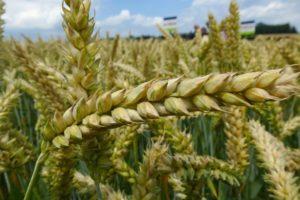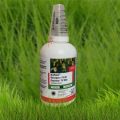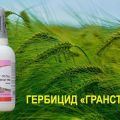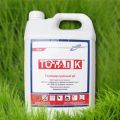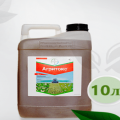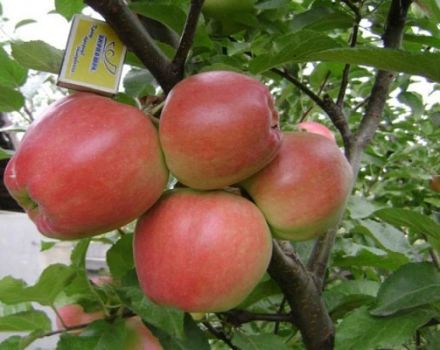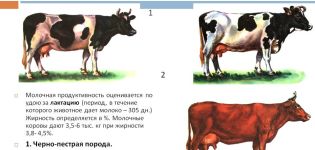Instructions for the use of herbicide Harmony, consumption rates and analogues
"Harmony" is a herbicide designed to get rid of dicotyledonous weeds after the germination of the main crop, acts selectively. The low consumption of the substance and the good result made it popular in large farms. The chemical protects corn, soybeans, wheat, barley, fiber flax from various types of weeds. Thus, it is much easier to grow crops in large volumes and increase the yield.
Content
- 1 Composition and release forms of the herbicide "Harmony"
- 2 The advantage of the drug
- 3 Mechanism of action
- 4 What weeds are most effective against
- 5 Consumption rates and preparation of working solution
- 6 Instructions for the use of the herbicide "Harmony"
- 7 Precautions for use
- 8 Drug toxicity
- 9 Certain restrictions on crop rotation
- 10 Compatibility with other products
- 11 Storage conditions
- 12 Herbicide analogs
Composition and release forms of the herbicide "Harmony"
Thifensulfuron-methyl (750 g / l) is the active ingredient "Harmony" (sulfonylurea class), in contrast to "Harmony classic", where thifensulfuron-methyl (187.5 g / kg) and chlorimuron-ethyl (187.5 g / kg). Dry viscous suspension is packed in plastic containers of 100 g.
The advantage of the drug
The agrochemical has a wide range of distribution, helps to save crops from weeds, the main advantages:
- convenient form of release;
- profitability;
- soft for flax and significantly increases the yield;
- in cereals it spreads very quickly;
- in tank mixtures, the effect of the drug increases, and due to this, the dosage is reduced;
- can be used at +5 ° С, the temperature does not affect the quality of processing.
- safe, half-life in soil - 6 days;
- allowed to use near water bodies;
- not dangerous for crops sown after.
Using the product allows you to increase the yield by 30-40%. Most of the reviews about him are positive, farmers use Harmony with success.

Mechanism of action
The active component of the drug enters the leaf plates of the weed, rapidly moving to the shoot growth zone, the root system. Thifensulfuron-methyl blocks acetolactate synthase, which is involved in the synthesis of amino acids. After several hours, the growth of harmful grass stops, chlorosis, wilting sets in. After 2-3 days, the weed shoots turn red, deform, the leaves fall off.
Particularly vulnerable grasses die after 1.5-2 weeks, the most resistant ones stop growing and are not dangerous for cultivated plants.
What weeds are most effective against
The herbicide destroys plants from the cruciferous, amaranth, and aster families. Too sensitive to the drug:
- horse mint;
- Mary white;
- chamomile;
- amaranth;
- piculnik;
- garden purslane;
- field talaban;
- foolish man;
- walker;
- nettle;
- horse sorrel.

Medium sensitivity are: wild poppy, dope, ragweed, medicinal smoke, field thistle, spurge.
Some herbicide-resistant grasses: small-flowered galinsoga, wild nightshade, field bindweed.
Consumption rates and preparation of working solution
Dilute the herbicide immediately on the day of application. The container of the sprayer is filled with water, turned on, a certain amount of the drug is added, if necessary, combined with another pesticide. Then turn off, add water, pour out "Trend 90" (200 ml / ha), start the mixer again.
The remedy is used for dicotyledonous annual weeds at the beginning of the growing season, when they have formed 2-4 leaves.

Consumption varies slightly for different plants.
| Culture | Harmony consumption (g) | Consumption with "Trend-90" (g) | Growth phase |
| Winter wheat | 20-25 | 15-20 | Tillering in the spring |
| Spring wheat, barley | 15-20 | 10-15 | 2-3 leaves until the end of the formation of new shoots |
| Soy | – | 6-8 | 1-2 true leaves before budding |
| Corn | 15 | 10 | 3-5 true sheets |
| Linen | 15-20 | - | Upon reaching 5-12 cm |
These numbers are based on 100 liters of water. The average rate is 25 g per 1 ha, the optimal solution of an agrochemical is 200-300 liters per 1 ha.
On corn with ragweed, thistle, bindweed, add the pesticide "Dicambu" to the tank mix.
On cereals, where marm and bindweed grow, it is recommended to mix Harmony and anti-grain herbicides to increase the effect.
In the fields with flax, the drug is combined with MCPA or chlorsulfuron; it is forbidden to use it together with graminicides and Trend-90.
On soy, "Harmony" is combined with preparations based on bentazol with the addition of "Trend-90".
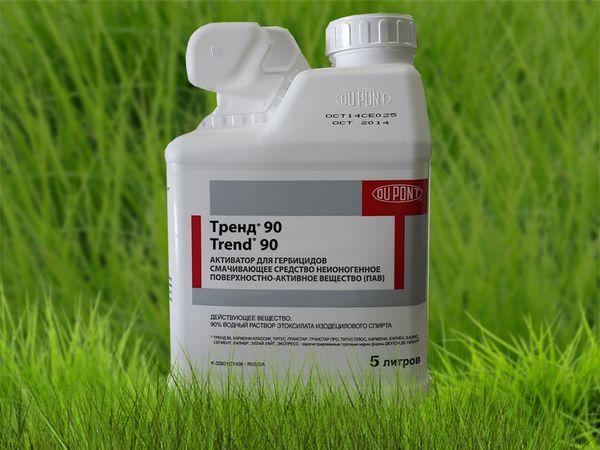
Instructions for the use of the herbicide "Harmony"
It is not advised to spray plants if they are susceptible to diseases, pests, also when there is a prolonged cold snap, dry weather, after rain, with dew.
Apply the product alone or together with Trend-90. Then add 1/10 liter of the "Trend" preparation per 100 liters of the working solution. Only one treatment is carried out per season.
Precautions for use
Before working with the drug, you should wear a protective suit, gloves, respirator, hat, boots. Avoid contact of the solution on the skin, mucous membranes.
Drug toxicity
The agrochemical is not dangerous for bees (4th class), for humans (3rd class), it is not toxic for reservoirs with fish.

Certain restrictions on crop rotation
Experienced agronomists recommend adhering to some rules:
- Where soybeans grew, sow exclusively this crop.
- Sow winter cereals after 3 months after spraying.
- In spring, it is allowed to sow soybeans, spring crops, oats, corn, peas.
- In the next season, after chemical treatment, include rapeseed and sunflower in sowing.
- In the second year, plant root crops: sugar beets, onions, potatoes.
Compatibility with other products
The agricultural product is allowed to be combined with pesticides, except for insecticides from the FOS group. Before mixing, testing is carried out by combining preparations in small quantities. It is advised to use another remedy after at least 5 days.

Storage conditions
The drug is stored in a dry room, where the temperature is 0 ... +30 C. Term - 3 years from the date of issue. The packaging must be intact, undamaged, otherwise the substance will not be effective.
Herbicide analogs
A similar effect is possessed by drugs with the same active component - thifensulforol-methyl:
- "Tifi";
- "Orion";
- "Formula".
They are effective on cereals, soybeans, corn, flax, and are used on large farms.
